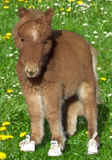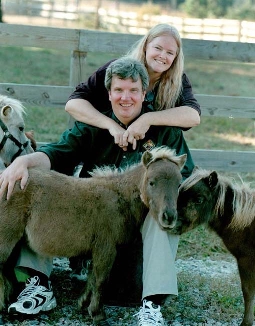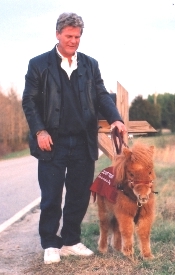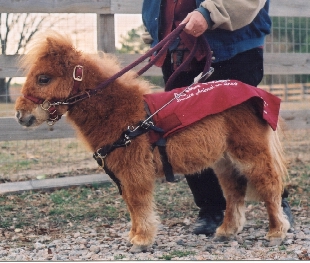|
|
Little Horses Face A Big Mission By Liz Russell Equine
Journal, July 2001
he stands just two feet high, but Cuddles is a miniature horse with a big mission. Soon, she will complete her training to become the world’s first full-time guide horse assisting a blind person. Wearing sneakers that prevent her feet from sliding on slippery floors, the little red roan makes history in 2001 as she begins working with her new handler, Dan Shaw of Ellsworth, Maine. She is one of ten tiny equines being trained by Janet And Don Burleson, who created The Guide Horse Foundation only a couple years ago. Equine InspirationWhile
mounted on rented horses in Manhattan
and headed for Central Park, retired professional horse trainer
Janet Burleson and her husband Don noticed how the horses respected the
city’s traffic flow and ignored the chaos and noise.
The horses followed traffic patterns as they merged with taxicabs
and commuters.
An idea struck the couple, then owners of just two Miniature
Horses. If horses , long-time service animals to human beings, could
learn to negotiate busy city streets, why couldn’t they be trained to
assist blind individuals? In
their North Carolina home after the 1998 trip to New York, the Burlesons
turned to piles of research and one of their pint-size horses, Twinkie,
for help in testing their guide horse theory.
Approximately the size of a traditional guide dog, Twinkie was
the prototype that proved Miniature Horses could perform guide animal
duties in a variety of places, including shopping malls and restaurants.
The Guide Horse Foundation was soon formed.
This non-profit charity is dedicated to providing free guides for
visually impaired individuals. Its
challenging mission involves providing a safe, cost-effective and
reliable mobility alternative to visually impaired people and delivering
the guides free to recipients.
“We choose to give the horses free because the training to
guide animals, traditionally dogs, is astronomical,” Janet says.
“Only the most affluent, blind people would be able to have a
guide.” She explains that
most guide dogs are provided free or for a nominal fee.
Few individuals could finance training, and for this reason the
program’s many volunteers and supporters are appreciated.
One of its supporters is best-selling author Patricia Cornwell,
Known for her series of crime novels.
Cornwell visited the Burleson’s farm while researching a novel
and donated six horses and funding for their care.
Horse farms, businesses and individuals have also donated horses
and equipment, while numerous volunteers and sponsors are relied on for
daily horse care, transportation and funding.
With years of experience training Arabian performance horses to
her credit, Janet develops the program and trains the guide horses with
Don’s help. Both are
volunteers. The couple seems pleased at the prospect of helping blind
individuals experience freedom while they’re finding a way to make
horses even more a part of human society. Horse Sense
As the
Burlesons researched the feasibility of guide horses, they discovered
historical evidence was stacked in their favor.
Horses have helped humans in many ways throughout the centuries,
from serving as the main mode of transportation to commissions in the
military to plowing fields. Miniature
Horses were used in Wales to haul coal in mines while cow horses have
tracked and herded cattle with uncanny accuracy.
Horses are also natural guides. Cavalry horses were known to
guide injured soldiers to safety. If
a member of a wild band of horses goes blind, another horse often
accepts responsibility to guide that horse.
Many blind people ride horses on trails and in competitions,
trusting the horse to lead them.
Numerous natural equine characteristics proved pertinent to guide
animal work. Horses have
great memories. They can
recall dangerous situations years after the first occurrence and retrace
traveled routes decades later. With
eyes on the sides of their heads, Horses have nearly 350 degrees of
vision and can see well in almost total darkness.
Because they are extremely sensitive to motion, they can detect
potential hazards before their blind handlers can.
They demonstrate excellent obstacle avoidance and judgment of the
safest route, as anyone who has ever ridden out on a trail can attest.
In addition, horses are hearty and robust.
Properly conditioned horses can easily travel miles without
difficulty. Though the
Burlesons emphasize their high respect for The Seeing Eye, which has
provided dogs for years, they point out that for some blind people
certain equine characteristics make guide horse more appealing.
Horses are a feasible alternative guide for people who are
allergic to dogs but not horses. Dogs
have a relatively short lifespan of eight to ten years, but miniature
horses live 25 to 35 years. One
guide horse may be sufficient to serve a mature individual for the rest
of his or her life, thereby preventing the traumatic experience of
losing a guide companion. Horses do not require constant attention; off-duty guide
horses are happiest at horseplay and grazing.
Like dogs, the guide horses can be housebroken. Making the CutThe suitability of guide horse candidates is determined on different levels. To be considered for the program a Miniature Horse must measure 22 to 26 inches high at the withers. Shorter horses would be inaccessible to adult handlers, and taller ones are too large for public transportation or to fit under restaurant tables. Candidates range in weight from 55 to 100 pounds. They must have a calm temperament, sound legs, good health and demonstrable stamina. Aggressive horses that would not bond with their handlers and flighty horses that would not become acclimated to sudden noises or readily accept new experiences are not suitable. A licensed veterinarian examines each knee-high prospect and only those that are certified sound are accepted. The candidates are also tested for field intelligence.
The Burlesons consider a series of factors as they try to assess
intelligence. They look at the horse’s ability to solve increasingly
complex problems and note how long it takes for a horse to learn a task
and how well it can remember learned behavior.
Research shows that intelligent horses are alert.
Alertness is noted through a high degree of ear mobility and
sensitivity to applied pressure. A
guide horse candidate must also appear to be socialized, a status
perceived through appropriate interaction with other horses and people.
Intelligent horses can follow a detour to reach a goal.
After a miniature horse is accepted for the guide horse program,
it is excused if it cannot be desensitized to extraneous environmental
stimuli or if it cannot be house broken.
A veterinarian provides periodic physical examinations to ensure
continued soundness and health. Excused
candidates are given homes where they can enjoy life as a pet or
companion animal. Riding HighReal-life trials and a favorable public response have the guide horses riding high on popular opinion. Blind volunteers tested the Burleson’s guide horses and reported positively on the horses’ abilities to keep them sage. Access to public places proved no obstacle, as the Americans with Disabilities Act makes prohibiting entrance to a service animal a federal offense. Service animals can enter stores, restaurants and public modes of transportation and are exempt from local, county and state animal restrictions. The Burlesons have become familiar sights to their North Carolina townships as training regimes with Cuddles and others include visiting local eateries and negotiating traffic. Interest is so high that The Guide Horse Foundation has a waiting list of dozens of prospective guide applicants, and it is besieged with requests for information and press interviews. Horse
Lovers Perspective guide horse recipients include visually impaired equestrians, people allergic to dogs and those desiring a guide animal with a long lifespan. The applicants are as carefully screened as their equine counterparts. Recipients must be at least sixteen years of age to assume full responsibility of the horse’s care. Because the horses are not suited to individuals who travel much or who live in urban environments, recipients must live in rural or sub-urban environments that allow the horses to “just be horses when they’re not working,” Janet says. “The ideal situation will be that the horse will have a fenced area to graze and run.” The Burlesons bring their Miniature Horses indoors for socializing, grooming and cuddling, but they are not house pets. “They are horses that graze,” Janet explains. Recipients must be mobile, and those who take long regular walks or who would use the horse daily are the best candidates. Handlers must also be committed to providing a loving home for the horse. The visually impaired recipients are given the right to use the horse’s service for life, but they must agree to a series of conditions. Follow-up visits must be allowed so that The Guide Horse Foundation can monitor the status of the animal and its working relationship with its owner. The foundation reserves the right to take the horse back under extreme circumstances, such as if the horse were being abused, neglected or exploited. Handlers do not have the right to sell the guide. After retirement, the horse may remain with the handler as a companion or be returned to the foundation. A horse can also be returned if the handler’s life changes in a way that makes the horse no longer useful as a service animal. Though all guide horse recipients must attend a four-week school on basic horsemanship at the Burleson’s farm before receiving their horse, ideal handlers are mature people who have grown up with and are knowledgeable about horses. “Initially, the majority of guide recipients are all horse people with a foundation in horse care; Dan Shaw is the exception,” Janet says. A long-time horse lover, Shaw’s first experiences with Cuddles include detailed on-site work and schooling. The horsemanship school involves lessons from a licensed equine veterinarian who teaches about health issues, signs of illness, and the importance of checkups, yearly vaccinations and worming. A farrier educates the students on hoof care and recognizing hoof problems.
Training
for the Mission The Burlesons relied on reams of research and Janet’s Background in horse training to develop their program. They studied guide animal material and consulted guide trainers and dog trainers. They worked extensively with blind people who could express needs and share past experiences with other guide animals. “You’re training for different skills, but you still use the same principles for teaching horses,” Janet says. She uses training techniques from a variety of sources, including popular trainer, lecturer and author John Lyons. She also uses the principles of operant conditioning, which were originally described by behavioral psychologist B.F. Skinner. Training guide horses “isn’t the same as training a horse to ride,” she explains. Their training involves many additional stages that a riding horse does not require. Guide horses learn to ride escalators and elevators, though they are trained to identify and use ramps whenever possible. They are introduced to many routine aspects of human life, such as going to a post office or a shopping plaza. They also learn to ride in passenger vehicles; some have to learn how to enter taxicabs and busses. No bit or other type of force is necessary, but the horses are fitted with a harness by which the handler holds the horse. Guide horses also learn to wear sneakers. The hooves of these tiny equines are too small for iron horse shoes; their hoof walls cannot hold nails. “Rubber horse shoes can be glued on,” Janet says, but the horses usually go barefoot. “They wear the shoes inside for traction on tile, waxed and hardwood floors which can be slippery against a flat hoof,” she says. Out of doors, Cuddles wears sneakers to protect her feet from broken glass and hot asphalt. Originally Don Burleson customized baby shoes for the horse’s hooves be removing the heels and sewing together the leather uppers in back. Now Sabre Equine donates sneakers made specifically for horses. Janet can train only six to ten horses per year because it takes thousands of hours to fully prepare a guide horse for service. As The Guide Horse Foundation gains funding, the Burlesons will continue to work on an unpaid volunteer basis, but they’ll hire additional trainers who will each be responsible for training six to ten horses. They want to increase the number of guide horses trained to accommodate their long list of blind applicants. Guide horse training can begin after weaning. Any professional trainer can handle the basic training program, which includes haltering, starting and stopping. Advanced guide horse training by the foundation provides for more specific skills and covers several main areas: basic leading, voice commands, obstacle avoidance, housebreaking and intelligent disobedience. Basic leaking includes teaching the horse to go forward at an appropriate speed and to respond while doing so to verbal commands, climb stairs, lie down and enter elevators. Voice training includes 23 voice commands that enable the visually impaired handler to direct any circumstance. Obstacle avoidance trains the horse to alert its handler of obstacles in the path, whether it’s a hole in the ground or a low overhang. Because horse naturally avoids obstacles, they have only to be taught that the handler is an appendage. Additionally, they are systematically desensitized to noise and commotion just as police horses are. They are taught not to spook at sudden noises and not to react to other animals when in harness. The horses are introduced to cats and dogs too, as they are apt to be exposed to them during guide service. Housebreaking is similar to that done with dogs. The Burleson’s prototype horse, Twinkie, was house trained in a week. Janet explains that in working with the Miniatures she and Don realized that the horses can learn to empty themselves at appropriate times and can hold elimination for up to six hours. They can also develop a habit of eliminating in a specific area. “There’s lots of difference between these small horses and the larger ones,” she says. While large horses tend to eliminate approximately every 45 minutes, Miniature Horses tend to eliminate every three to four hours. “It’s normal for them,” she says, and that makes house training for longer periods of five to six hours possible. The horses are taught to paw at a door or nicker when they need to eliminate. Intelligent-disobedience training involves teaching the horse to ignore commands that would lead it and it’s handler into an unsafe situation, such as walking across a street when cars are approaching. In this phase of training the horse gains the ability to judge whether a situation is safe. A completely trained guide horse has focus and is not easily distracted form its task. Mission
Completed The end of the training phase involves recipient integration and finetuning. When it is time for the guide horse and its new handler to meet, the recipient is transported free of charge to the Burleson’s farm. Staff and volunteers support the handler and horse team as they bond to form a mutually helpful relationship. As cuddles and Dan Shaw spend their first summer together, Cricket, the world’s second full-time guide horse, prepares for integration into the life and independence of Cheryle King of Washington state. How fast the guide horse program expands remains to be seen. But if the waiting list of applicants is any indication, it will continue to grow. With thorough training in the skilled hands of Janet and Don Burleson, these little horses are destined not only to help their visually challenged handler maintain independence, they’re bound to capture to hearts and gratitude of all they serve. If you ask Janet Burleson whether the horses like their work, she laughs lightly. “You know horses, they enjoy doing things that please people – and they love the attention.”
|
Guides Training Press Photos News Apply FAQ Volunteers Wishes Contact Home
Copyright © 1998, 1999, 2000, 2001, by the Guide Horse Foundation Inc.
Guide Horse ® is a registered trademark of the Guide Horse Foundation Inc.
The Guide Horse Foundation has the utmost respect for The Seeing Eye® and their seventy-two years of outstanding work with assistance animals for the blind. Please note that The Guide Horse Foundation is not affiliated with or sanctioned by the Seeing-Eye® or any of the Guide Dog training organizations. Seeing-Eye® is a registered trademark of the Seeing-Eye, Inc.
Заказать Доставку цветов в Уинское dostavka-byketov.ru.










